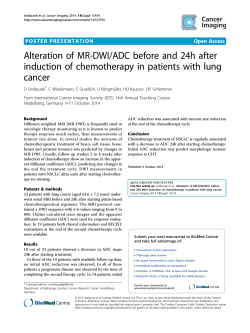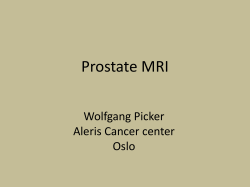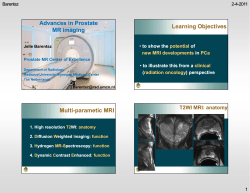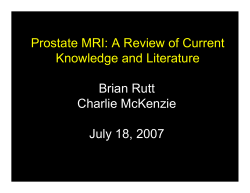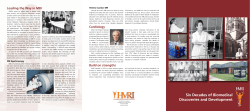
Prostate MRI Workshop J. Barentsz, Nijmegen, NL 㻌
Prostate MRI Workshop J. Barentsz, Nijmegen, NL㻌 Prostate MRI Workshop 1. Introduction 2. 3. 4. 5. 6. Acquisition Technical issues Interpretation/Reporting Indications/Clinical relevance Future perspectives Prostate MRI Workshop 1. Introduction 2. 3. 4. 5. 6. Acquisition Technical issues Interpretation/Reporting Indications/Clinical relevance Future perspectives Multi-parametric MRI • T2-Weighted Imaging: anatomy • Diffusion Weighed Imaging: biology • Dynamic Contrast enhanced: vascularity • MR Spectroscopic Imaging: metabolic T2W PCa, prostatitis, hematoma, fibrosis: low SI T2W • High resolution: cornerstone of imaging • Low specificity: should be used with • DWI + DCE + MRSI • Post biopsy haemorrhage artefact: • In staging wait 4-6 weeks • In detection do not wait DWI Organised galandular tissue Tightly packed cellular tissue DWI: PCa restricted H2O movement c. A. Padhani DWI • Essential component of mp-MRI • High specificity: agression • Low SNR: low spatial resolution • Susceptibility artifacts DCE DCE MRI: PCa increased vascular permeability Sensitivity! DCE •High sensitivity: detection •Essential in “recurrence detection” •Low specificity: false positives •Limited standardization •No standardized calibration & analysis •Costs MRSI • Specificity especially in TZ • in PZ: DWI=MRSI • Expertise is needed • Time consuming • Requires ERC MRSI For Ferrari drivers only? MRSI You need EXPERIENCE how to drive Prostate MRI Workshop 1. Introduction 2. 3. 4. 5. 6. Acquisition Technical issues Interpretation/Reporting Indications/Clinical relevance Future perspectives Acquisition (minial requirements)㻌 Good, simple, fast 1. Detection (30 minutes) 2. Staging (40 minutes) 3. Bone and Nodes (30 minutes) Detection㻌㻌 • No ERC, Buscopan/Glucagon • 2x T2W. ax + sag. (4/3 x 1/.5 x 1/.5): 9’ • DWI ax (b 0/50, 100, ≥800, ADC): 18’ • DCE ax: GRE, time res. <15 sec 30’ • T1-axial: local hematoma (with DCE) Staging㻌㻌 • ERC, Buscopan/Glucagon 10’ • 3x T2-W.. (3 x .3/.7 x .3/.7): 20’ • DWI ax (b 0/50, 100, 800, ADC): 30’ • DCE: GRE, axial, time res. 2-15 sec 40’ • (MRSI) 50’ Node and bone Recurrence, or PSA>15, Gl>7, DRE T3㻌㻌 • 3D T1-WI tSE (.9x.9x.9) 6’ • DWI cor (b 50, 800, ADC): 14’ • C-T-L spine: sag. T1WI and STIR 30’ or better: protocol presented by Padhani Prostate MRI Workshop 1. Introduction 2. 3. 4. 5. 6. Acquisition Technical issues Interpretation/Reporting Indications/Clinical relevance Future perspectives Technique: MR-coils “a continuing debate” • ERC+PPA: state-of-the-art for staging • Not needed for detection (esp. at 3T) • Costs time, money, acceptance Further considerations: - is knowledge of minimal ECE needed? - perform comparative studies Technique: 3T “Still a research topic” • High SNR: - no ERC, improved DWI, MRSI • Susceptibility artifacts (esp DWI) • SAR • (Shorter T2-RT, longer T1-RT) • (Inhomogeneity of magnetic field) Prostate MRI Workshop 1. Introduction 2. 3. 4. 5. 6. Acquisition Technical issues Interpretation/Reporting Indications/Clinical relevance Future perspectives Interpretation / Reporting㻌 PI-RADS 5 point scale: probability of significant PCa PI-RADS Classification System Score T2W 1 Criteria PZ and TZ separate Score DWI Criteria 1 No reduction in ADC compared to normal glandular tissue. No increase in signal on any In PZ: uniform high signal intensit; In TZ: heterogeneous transitional zone adenoma with well-defined margins: “organised high b-value image (>b800) chaos" 2 2 Diffuse, hyper intensity on >b800 image with low ADC; No focal features - linear, triangular or In PZ: linear or geographic areas of lower SI in TZ: areas of more omogeneous low SI, however well marginated geographical features allowed 3 Intermediate appearances not in categories 1/2 or 4/5 3 Intermediate appearances not in categories 1/2 or 4/5 4 In PZ: discrete, homogenous low signal focus/mass confined to the prostate In TZ: ill defined areas of more homogeneous low SI: “erased charcoal sign” 4 Focal area(s) of reduced ADC (>900-1000) but iso-intense signal intensity on high b-value 5 images (>b 800) In PZ: discrete, homogeneous low signal intensity focus with extra-capsular extension /invasive behaviour or mass effect on the capsule (bulging), or broad contact (>1.5 cm) with capsule 5 Focal area/mass of hyper intensity on the high In TZ: same as 4 but involving the AFM or anterior horn of the PZ, usually lenticular or water- b-value images (>b 800) with reduced ADC drop shape (>900-1000) Score DCE Criteria 1 Type 1 enhancement curve Score MRSI Criteria 1 Citrate peak exceeds choline peak >2 times 2 Citrate peak exceeds choline peak >1-2 times 2 Type 2 enhancement curve 3 Type 3 enhancement curve 3 Choline peak equals citrate peak +1 For focal enhancing lesion with curve type 2 or 3 4 Choline peak exceeds citrate peak >1-2 times +1 For asymmetric lesion or lesion at an unusual place 5 Choline peak exceeds citrate peak >2 times with curve shape 2 or 3 PI-RADS: T2WI PZ㻌 Score T2W PZ Criteria 1 Uniform high SI 2 Linear, wedge shaped or geographic areas of lower SI, usually not well demarcated 3 Intermediate appearances not in categories 1/2 or 4/5 4 Discrete, homogenous low SI focus/mass confined to the prostate 5 Discrete, homogeneous low SI focus with ECE/invasive behaviour, or mass effect on capsule (bulging), or broad contact with capsule (>1.5 cm) T2W: PZ PI-RADS: T2WI TZ㻌 Score T2W TZ Criteria 1 Heterogeneous TZ adenoma with well-defined margins: “organized chaos” 2 Areas of more homogeneous low SI, however well marginated, originating from the TZ/BPH 3 Intermediate appearances not in categories 1/2 or 4/5 4 Areas of more homogeneous low SI, ill defined: “erased charcoal drawing sign” 5 Same as 4, but involving the anterior fibromuscular stroma or the anterior horn of the PZ, usually lenticular or water-drop shaped. PI-RADS: T2WI TZ㻌 Pi-RADS: T2WI TZ㻌 BPH: organised chaos “Erased Charcoal drawing sign” PI-RADS: DWI㻌 Score Criteria 1 No reduction in ADC compared to normal glandular tissue. No increase in SI on any high b-value images (≥b 800) 2 Diffuse, hyper SI on ≥b 800 image with low ADC; no focal features - linear, triangular or geographical features allowed 3 Intermediate appearances not in categories 1/2 or 4/5 4 Focal area(s) of reduced ADC (>900-1000) but isointense SI on high b-value (≥b800) images 5 Focal area/mass of hyper SI on the high b-value images (≥b800) with reduced ADC (<900-1000) PI-RADS: DWI㻌 PI-RADS: DCE㻌 Score Criteria 1 Type 1 enhancement curve 2 Type 2 enhancement curve 3 Type 3 enhancement curve +1 For focal enhancing lesion with curve type 2 or 3 +1 For asymmetric lesion or lesion at an unusual place with curve shape 2 or 3 PI-RADS: DCE㻌 Interpretation / Reporting㻌 PI-RADS Not the sum score But dominant technique determines presence of significant cancer Interpretation / Reporting㻌 PI-RADS dominant technique: TZ: T2W PZ: DWI Recurrence: DCE Post Rth Extra Capsular Extension (T3a)㻌 Also 5 point score? 1 Abutment 3 Irregularity & NVB thickening 4 Bulge, loss of capsule & capsular enhancement, obliteration recto prostatic angle 5 Measurable extra-capsular disease ECE㻌 Seminal Vesicle Invasion㻌 Also 5 point scale? 1 2 3 5 Expansion Low SI on T2WI Filling in of angle Restricted diffusion and enhancement in low SI area SVI㻌 Prostate MRI Workshop 1. Introduction 2. 3. 4. 5. 6. Acquisition Technical issues Interpretation/Reporting Indications/Clinical relevance Future perspectives Indications㻌 First presentation TRUS-biopsy (10-14 cores) Biopsy positive # of cores % of each core positive Curative intent Patient factors: life expectancy, comorbidities, preference Staging MRI with bone and node MRI in high risk (PSA>15 or Gleason>7, or DRE T3) Active surveillance Staging MRI to confirm grade and extent T2WI, DWI, DCE, (MRSI) Biopsy negative Clinical follow up Re-measure PSA Biopsy negative and clinical suspicion PCa Detection MRI and then biopsy (TRUS guided by MRI or MR-guided biopsy in some specialist units) Multi-parametric MRI 1. Mp-MRI predicts tumor aggression 2. Mp-MRI (95%) predicts low vs intermediate/high grade better than TRUS (56%) 3. After neg. TRUS-Bx, mp-MR-Bx is positive in 41% showing 87% significant Ca 4. Standardization guidelines (PI-RADS) are published and implemented (ACR) How to be a “winner” Take an “easy case”, in which you will certainly make a success: - many neg. TRUS-Bx and high PSA (>25), than look for anterior or apex tumor. Patient 62 y, PSA 28 8x neg. TRUS Bx (96 cores) BPH BPH normal Patient 62y: Your diagnosis? 1.7 cm line normal Patient 62 y 1.7 cm m lin li line in ne e Next step ? MR-guided Bx Gleason score 4+3 MR-GB No. of patients Detection rate Min. previous negative TRUS bx Beyersdorf 12 42 1 Engelhard 37 37 1 Anastadiasis 27 56 1 Hambrock 71 59 (93) 2 Franiel 54 39 1 Roethe 100 52 (81) 1 Hoeks* 438(256) 41 (86) 1 Author Why Multi-parametric MRI? Sciarra et al Eur Urol 2011 ESUR Prostate MR Guidelines 2011 㻌 㻌 Claire Allan, Michel Claudon, Francois 㻌 Cornud, Ferdinand Frauscher, Nicolas 㻌 Grenier, Alex Kirkham, Frederic Lefevre, 㻌 Gareth Lewis, Ulrich Muller-Lisse, Anwar Padhani, Valeria Panebianco, Pietro Pavlica, 㻌 Phillipe Puech, Jarle Rorvik, Andrea Rockall, 㻌 Catherine Roy,Tom Scheenen, Harriet Thoeny, Baris Turkbey, Ahmet Turgut. 㻌 Questions? Jelle Barentsz Prostate MR Center of Excellence Department of Radiology Radboud University Nijmegen Medical Center j.barentsz@rad.umcn.nl
© Copyright 2025
